Today, we present the roll call of the honorees, which were mostly presented in alphabetic order. As before, I have prepared some thumbnail bios of each in the same order as they awards were given; the bios of the 14 awardees not present follow. Unfortunately, I couldn’t always find enough information on everyone; I trust some of our readers will be able to fill in the gaps and provide corrections. They honorees are introduced by Karan Storr and Bud Hester keeps making the same comments to almost every honoree, who are not allowed to say much beyond thank you. The one exception being Grim Natwick, owing I guess to his seniority (among other things).
Roll Call

Art Babbitt (Arthur Harold Babitsky), began working in animation in 1924 doing theatrical commercials, including some “Quick Henry the Flit” spots devised by Dr. Seuss. He moved to Terrytoons in 1929 and Disney in 1932, where he helped develop Goofy, and worked on Snow White (the Queen) and Fantasia (mushroom dance). Babbitt lost favor with Disney after his leadership role in the 1941 strike. After the war, he was a character designer for Lou Bunin’s puppet version of Alice in Wonderland, before animating at UPA (Rooty Toot-Toot). He then focused on TV commercials, first as a partner in Quartet Films and then for Hanna-Barbera. He ended his career with Richard Williams, working on commercials and The Thief and the Cobbler, while helping to train his staff in classic animation techniques.
Bob Bemiller (Robert Bemiller) broke into animation working at Boyd Lavaro-Marty Monk Productions (aka Romer Grey Studios) in 1935. He then worked at Mintz, Fleischer, MGM, Lantz, John Sutherland and Disney. However, he became best known for his work in TV; this included stints at TV Spots (Crusader Rabbitt), Snowball, DePatie-Freleng (Pink Panther shorts), Filmation (She-Ra: Princess of Power), Sunbow/Marvel (Transformers), and Hanna-Barbera (The Smurfs). He also worked for Christian Mission Films and the March of Dimes.
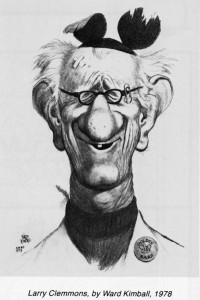 Ed Benedict is best known for his work at Hanna-Barbera, where he basically established its house style that set the standard for TV animation; as such, he was a major influence on any number of today’s animation artists. He began at Disney in 1930 before animating at Lantz and Mintz. With Jerry Brewer he formed the short-lived Benedict-Brewer studio doing theatrical commercials. After a stint at Cartoon Films, Ltd., he returned to Disney as a layout artist (Make Mine Music). In 1949, Benedict joined Paul J. Fennell Co. (TV commercials and industrials), where he first adopted the modernist UPA aesthetic, which he took with him to MGM, where he caught the attention of Bill Hanna and Joe Barbera.
Ed Benedict is best known for his work at Hanna-Barbera, where he basically established its house style that set the standard for TV animation; as such, he was a major influence on any number of today’s animation artists. He began at Disney in 1930 before animating at Lantz and Mintz. With Jerry Brewer he formed the short-lived Benedict-Brewer studio doing theatrical commercials. After a stint at Cartoon Films, Ltd., he returned to Disney as a layout artist (Make Mine Music). In 1949, Benedict joined Paul J. Fennell Co. (TV commercials and industrials), where he first adopted the modernist UPA aesthetic, which he took with him to MGM, where he caught the attention of Bill Hanna and Joe Barbera.
Preston Blair (Preston Erwin Blair) is best known as an animator for his work at MGM under Tex Avery, especially for the character of Red in Red Hot Riding Hood; as an author, he is famed for the series of pioneering instructional books published by Walter Foster, starting with Animation (1948). He began at Romer Grey in 1930, followed by jobs at Lantz, Mintz and Disney (Fantasia); he joined the 1941 Disney strike, at which time he was making $67.50 a week. He then went to MGM where he eventually co-directed Barney Bear cartoons with Mike Lah. Blair later worked for his brother Lee’s Film Graphics, Hanna-Barbera (The Flintstones) and Fred Ladd (Pinocchio in Outer Space), as well as opening Preston Blair Productions. His sister-in-law was Mary Blair.
Brad Case began at Ub Iwerks in 1934 before moving to Disney. At the time of the Disney strike, he was a junior animator making $47.50 a week, but later moved into effects animation (Song of the South). Before going into TV animation, he also worked at MGM and Lantz. Case made his directorial debut with Bozo: The World’s Most Famous Clown at Larry Harmon. He subsequently picked up work from a variety of studios as an animator (The Yogi Bear Show and The 2000 Year Old Man), layout artist (The Flintstones), animation director (My Little Pony: The Movie and Muppet Babies), and director (The Dick Tracy Show).
Larry Clemmons started at Disney as an inbetweener in 1932, working on Mickey Mouse cartoons. He became a story artist (The Reluctant Dragon), before leaving the studio after the 1941 walkout (he was not a striker). From 1946-55, he was a radio writer for Bing Crosby, but returned to Disney as a writer and segment producer on The Mickey Mouse Club; he then wrote Walt’s spoken introductions to shows such as Walt Disney Presents. Clemmons ended his career writing for such films as The Jungle Book, The Rescuers and The Fox and the Hound.
Marie Harvey Cornell was an ink and paint artist who began her career in 1935 at Tate’s Tales. This was followed by stints at Lantz, MGM, UPA, Universal, Hal Roach, Disney, Paul Fennell, Filmfair, Filmation, Warner Bros., Celine Miles, Sid Glenar, Claire Ishkanian and Hanna-Barbera.

Rex Cox started in 1934 at Mintz before joining Disney, where he was an animator (mostly on shorts like The Autograph Hound) and story artist (The Clock Watcher); he was serving in both these capacities at the time of strike, when he was listed on a picket roster as making $60.00 per week. He stayed with Disney through the war, went on to Lantz, then moved to the New York area; there, Cox apparently worked on documentaries at the Princeton Film Center and commercials at Sarra, WCD Productions and MPO Television Films.
Jack Cutting (Jack Walter Cutting) spent his career at Disney, starting in 1929 as an inbetweener. He became the studio’s first assistant director before directing such cartoons as The Ugly Duckling. He was part of El Grupo who accompanied Walt Disney on his famed tour of South America in 1941. After the war, he oversaw the dubbing of Disney films into various foreign languages.
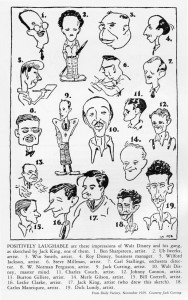 Suzi Dalton was an ink and paint artist who started in 1934 at Boyd LeVero; this was followed by stints at Mintz, Schlesinger, Iwerks, MGM, Betty Brennan, Lantz, Snowball, Hanna-Barbera, Filmation, Celine Miles, Bakshi-Krantz (final checker on Heavy Traffic) and Cannawest.
Suzi Dalton was an ink and paint artist who started in 1934 at Boyd LeVero; this was followed by stints at Mintz, Schlesinger, Iwerks, MGM, Betty Brennan, Lantz, Snowball, Hanna-Barbera, Filmation, Celine Miles, Bakshi-Krantz (final checker on Heavy Traffic) and Cannawest.
Mary Tebb (Mary R. Tebb) began at Disney in 1926 and seems to have done all the inking on The Skeleton Dance. At Iwerks, she became Ink and Paint Supervisor. Tebb dropped out of animation for a while before joining Katz (i.e., Leon Schlesinger). She returned to Disney in 1945 as inker and painter, working on shorts like The Social Lion; Tebb ended up running the Color Model Department.
Marc Davis (Marc Frasier Davis), one of Disney’s “Nine Old Men,” spent his entire career at the Mouse House beginning in 1935. He worked on Snow White, Bambi and 101 Dalmatians, and was best known for his animation of female characters such as Tinker Bell, Cinderella, Sleeping Beauty, Maleficent and Cruella de Vil. In 1961, he started designing attractions for the New York World’s Fair, Disneyland, Disney World and Tokyo Disneyland, including Great Moments with Mr. Lincoln, Pirates of the Caribbean and The Haunted Mansion. He also taught drawing at the Chouinard Art Institute and endowed the Motion Picture Academy’s annual Marc Davis Celebration of Animation.
Xenia De Mattia (Xenia Beckwith/Xenia) was one the earliest women animators, who started at Iwerks in 1933, presumably in ink and paint. She later worked at Mintz, Skippy, MGM and went to Fleischer in Miami as an inbetweener. She returned to ink and paint at Lantz, but soon moved up to animation. She then went to Disney (initially as an assistant then animator, as well as doing voice work on For Whom the Bull Tolls), UPA (Mr. Magoo’s Christmas Carol), Filmation (The Archie Show), Chuck Jones (The Phantom Tollbooth), DePatie-Freleng (The Super 6), Hanna-Barbera (Charlotte’s Web), and Bakshi (American Pop). She married and divorced animators Ralph Sommerville and Ed De Mattia.

Carl Fallberg (Carl Robert Fallberg) began at Disney in 1933 as an assistant director and storyman. In the latter capacity, he worked on Fantasia (“The Sorcerer’s Apprentice”) and Bambi. During World War II, he served in the Marine Corps’ film unit in Quantico, Virginia. He later worked as a storyman and story director for Warner Bros. and Hanna-Barbera (The Flintstone Comedy Hour and The Addams Family). At Disney, Fallberg started his parallel career as a comic book/strip artist, including his Fiddletown & Copperopolis comic strip for Railroad Magazine.
Jerry Hathcock (Robert Gerald Hathcock) started out as an inbetweener at Iwerks in 1934. He spent some time at Screen Gems before taking a job as an assistant animator on Fantasia. After a brief stint in the aerospace industry, he became an inbetweener at MGM before returning to Disney; Hathcock stayed there for 16 years, animating on Peter Pan, The Lady and the Tramp and TV commercials. He became a supervising director at Larry Harmon (Bozo the Clown) and UPA, before starting a 16-year stint at Hanna-Barbera (The Jetsons, Top Cat and Charlotte’s Web). He ended up working on commercials for Filmfair and Quartet. He served as vice president of the Screen Cartoonists Guild and was a charter member of The Animation Guild. His son is producer Bob Hathcock.
Charlotte Huffine (Charlotte Darling/Charlotte Darling Adams) is best known for her role in the founding of the Screen Cartoonists Guild and as a friendly witness before the House Un-American Activities Committee. She started her career in 1933 at Ed Fox Productions (Ted Eshbaugh’s L.A. studio), but after 6 weeks moved to Schlesinger as an inker and then background artist. She then worked for MGM, Lantz and became an assistant at Disney. Huffine briefly worked as an animator, but apparently decided to go back to assistant work to avoid a layoff (she was then a single mom). She also worked for UPA, Tex Avery, Rod Scribner (she was his final assistant), Hanna-Barbera (Charlotte’s Web, Heidi’s Song) and Bakshi (Coonskin, Wizards). She was once married background artist Ray Huffine.
Volus Jones (Volus C. Jones) began at Disney as an inbetweener in 1934 before becoming an animator; there, he was known as “The Duck Man” for his work on Donald Duck cartoons. He picketed during the Disney strike, at which time he was making $60.00 a week. He left for Screen Gems, but eventually returned to Disney, working on such films as Chip an’ Dale and the 3-D stereo Working for Peanuts. Starting in the last half of the 1950s, Jones worked at a number of studios, including Larry Harmon (Bozo), UPA (Gay Puree), Hanna-Barbera (Scooby Doo, Where Are You!, Charlotte’s Web) and Bakshi (Heavy Traffic)
Katie Kerwin (Katherine Kerwin) spent her animation career at Disney, starting in 1935, in ink and paint.
Ward Kimball (Ward Walrath Kimball), one of Disney’s “Nine Old Men,” started in 1934 as an inbetweener. He animated on Pinocchio (Jiminy Cricket), Dumbo (Crows), and The Three Caballeros (title song sequence). He co-directed Toot, Whistle, Plunk and Boom and directed It’s Tough to Be a Bird. On his own, he made Escalation, an anti-Vietnam War short. He was also involved in the production of various episodes of the Disneyland TV series. On the side, he was the leader of the Firehouse Five Plus Two jazz band made up of Disney animators.
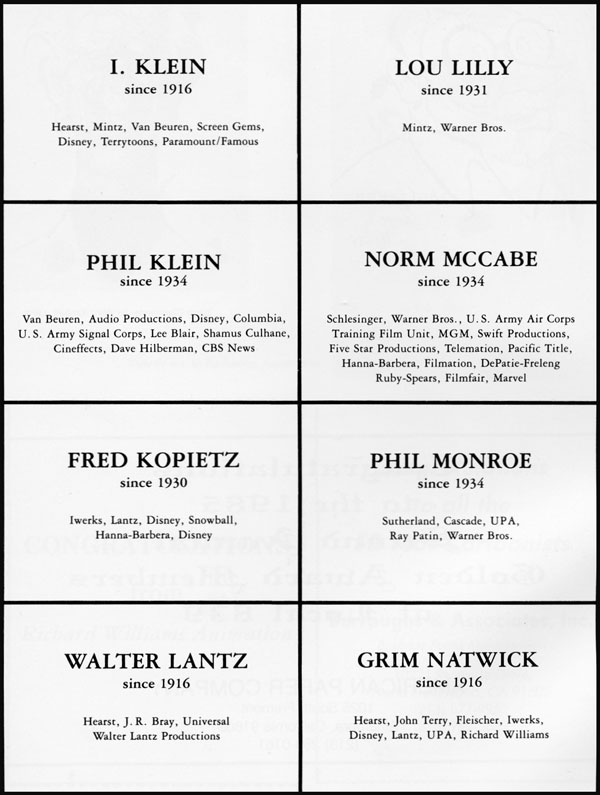
Lou Lilly (Louie Haskall Lilly) began in movies working as an extra and wardrobe boy before joining Mintz in 1931. Between 1940-44, he was a storyman and animator for Schlesinger (Russian Rhapsody). Lilly then went to Jerry Fairbanks, as a writer and director on the Speaking of Animals comedies and industrial films. In 1951, he established Lou Lilly Productions, which made TV commercials.
Phil Monroe (Philip Milton Monroe) started at Schlesinger in 1934 and soon became an animator (Hillbilly Hare). He was best known there for his work with Chuck Jones (Fast and Furry-ous). During World War II, he served in the First Motion Picture Unit. He moved to UPA in 1951 (The Unicorn in the Garden), followed by a stint at Ray Patin Studios doing commercials. He then became head of Warner’s Commercial Department in 1959, where he directed the Charlie the Tuna spots, before moving back into animating on shorts until 1963. He ended his career at Chuck Jones Productions.
Grim Natwick (Myron H. Natwick) originally had ambitions to be an illustrator and did designs for sheet music before entering the early animation industry. He became famous for designing and animating Betty Boop. This led him to Iwerks, where at one point he seemed to run the studio. At Disney, he helped design and animate Snow White and returned to Fleischer when it moved to Miami. He subsequently worked at Lantz, UPA (Rooty Toot Toot, TV commercials), Joe Oriolo (Felix the Cat) and Richard Williams (The Thief and the Cobbler). He was also involved in one of the early attempts to organize an animation union in L.A. He was the only honoree to be asked to say a few words: “I hope you have all enjoyed animation as much as I have. It’s such a gang sort of a business. I think we all do enjoy it. That’s about all.” He took a bit more of the spotlight a few years later during his 100th birthday party in 1990, a few months before his death. The actress Mildred Natwick was his first cousin.
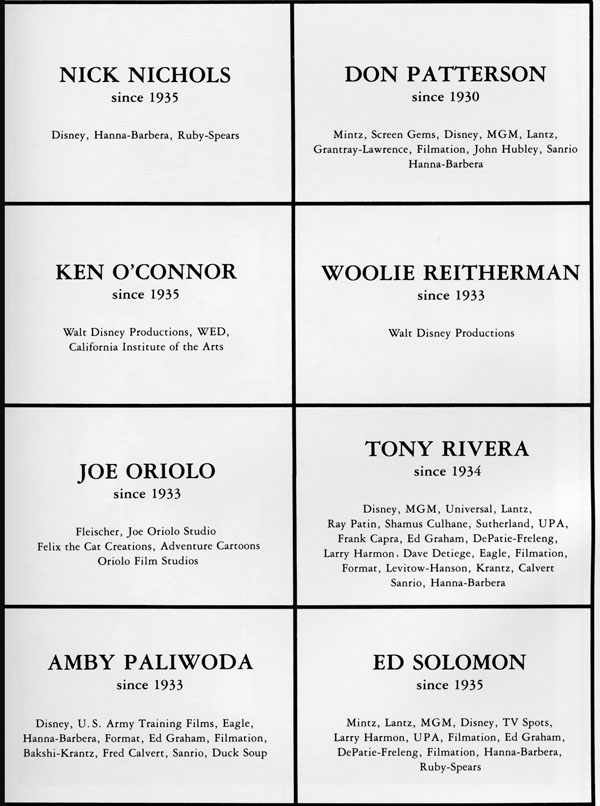
Nick Nichols (Charles Augustus Nichols) started his career at Disney in 1935, working on such films as Pinocchio. In 1944 he became a director (Pluto cartoons and Toot Whistle Plunk and Boom). He subsequently moved over to Hanna-Barbera (Charlotte’s Web and The Scooby-Doo Show) and Ruby-Spears (Alvin and the Chipmunks), as well as returning to Disney (Goof Troop).
Ken O’Connor (Kendall O’Connor) was born and raised in Australia and started out as a newspaper reporter and illustrator before studying art. He moved to the U.S. in 1930 where he worked as a commercial artist before joining Disney in 1935. He moved up from inbetweening, to effects animation, rotoscoping and layout; O’Connor first made his mark on such films as Pinocchio, Fantasia (“Dance of the Hours”), and Dumbo (“Pink Elephants on Parade”). Other credits include Education for Death, Cinderella and Toot Whistle Plunk and Boom. He also served as art director on several Disney TV shows. He officially retired in 1978, but did consult on various Disney theme park projects and taught layout and art direction at CalArts.
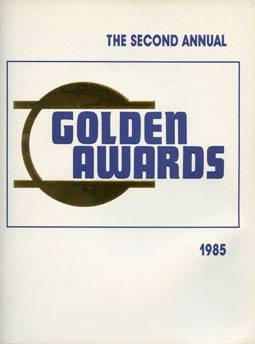
The Program Book cover
Amby Paliwoda (Ambrozi Paliwoda) began at Disney in 1935, becoming an animator, leaving in 1960 in the layoffs after 101 Dalmatians. (During the war, he worked on Army training films.) Paliwoda subsequently animated for a variety of studios, including Hanna-Barbera (The Flintstones), Filmation (Hey, Hey, Hey, It’s Fat Albert, Archie’s Funhouse) and Bakshi (Coonskin). He was also one of the signers of the original petition that led to the formation of The Animation Guild in 1951.
Don Patterson seems to have begun his career at Mintz in 1930, later animating for Disney on Pinocchio, Fantasia and Dumbo. He went to MGM before animating and directing at Lantz (Woody Woodpecker) in the 1950s. Patterson then worked as animator or animation director for Grantray-Lawrence (a company co-owned by his younger brother Ray Patterson), Hanna-Barbera (The Flintstones, The Huckleberry Hound Show, Jonny Quest), Filmation, Hubley and Film Roman (The Twisted Tales of Felix the Cat).
Woolie Reitherman (Wolfgang Reitherman), one of Disney’s Nine Old Men, is perhaps most familiar to the public as the director of such films as 101 Dalmatians, The Jungle Book and The Rescuers. He was born in Germany and spent his entire career at Disney, starting in 1933. He soon became an animator on shorts before shifting mostly to features, starting with Snow White, Pinocchio (animation director), and Fantasia (animation supervisor, “Rite of Spring”). He also animated on several Goofys. When Disney died in 1966, he became a producer of all the studio’s animated features.
Tony Rivera (Antonio Rivera) started at Disney in 1934 and became one of Grim Natwick’s assistants on Snow White. By the time of the Disney strike, he was a story sketch artist making $57.00 a week. Rivera subsequently worked at a variety of studios, mostly as a layout artist, including MGM, Lantz, John Sutherland, UPA (Mister Magoo TV series), Hanna-Barbera (The Huckleberry Hound Show, The Yogi Bear Show, The Scooby-Doo/Dynomutt Hour), Levitow/Hanson (B.C.: The First Thanksgiving), and Krantz (The Nine Lives of Fritz the Cat).
Ed Solomon, animator and animation director, began at Mintz in 1935, followed by stints at Lantz, MGM and Disney. During the TV era, he mostly worked as an animator and sometimes as a director for such studios as TV Spots, Larry Harmon (directing on Bozo: The World’s Most Famous Clown), UPA (Mr. Magoo’s Christmas Carol), Filmation (Archie’s Funhouse), DePatie-Freleng, Hanna-Barbera (The All-New Super Friends Hour) and Ruby Spears (Heathcliff).
Paul Sommer, who worked variously as an animator, story director, layout artist and director, started at Terrytoons in 1934. He moved on to MGM (The Lonesome Stranger), Screen Gems, Swift-Chaplin, TV Spots, and Hanna-Barbera (The Huckleberry Hound Show, The Yogi Bear Show, Jonny Quest, Space Ghost).


HONOREES NOT PRESENT:
Ken Anderson (Kenneth B. Anderson), who studied architecture in college, started out in live action as a sketch artist at MGM before applying for a job at Disney. There he found himself working on Silly Symphonies, including Three Orphan Kittens, before transitioning to features as an art director on Snow White, Pinocchio and Fantasia. Later, he was also used as a story sketch artist/character designer (Shere Khan in The Jungle Book) and production designer (101 Dalmatians). His architectural skills were used to help design such Disneyland attractions as Mr. Toad’s Wild Ride.
Art Davis (Arthur Davis) was one of lesser-known directors from Warner Bros.’ Golden Age, His career dated back to 1923, when he started as an errand boy at the Jefferson Film Corporation (Mutt and Jeff). At Fleischer Davis was apparently the industry’s first inbetweener before becoming an animator. At Mintz/Screen Gems he was a story artist, animator and director. At Warner Bros., he took over Bob Clampett’s unit, making such films as Bowery Bugs. At DePatie-Freleng he directed Pink Panther cartoons and ended his career at Hanna-Barbera. His older brother was veteran Terrytoons director Mannie Davis.
Isadore Ellis (Izzy Ellis) began in 1929 at Winkler/Mintz before going to Iwerks. He is best known for his work at Schlesinger/Warner Bros. animating for Frank Tashlin (I Got Plenty of Mutton), Bob Clampett (A Tale of Two Kitties), Norman McCabe and Bob McKimson. This was followed by mostly TV work for such studios as Larry Harmon (Bozo: The World’s Most Famous Clown), UPA (The Dick Tracy Show) and Hanna-Barbera (Wacky Races).
 Andy Engman (Andrew Alfons Engman), the Finnish-born character and special effects animator, spent most of his career at Disney. He probably started out in ink and paint at Aesop Fables before moving on to Mintz, Fleischer (where he became an inbetweener) and Van Beuren. Engman ended up at Disney in 1937, where he spent the rest of his time in animation. Most of his credits were for such shorts as Goofy’s Glider and Donald’s Gold Mine; his only feature credit was as an effects animator for Make Mine Music. He ended up as part of management.
Andy Engman (Andrew Alfons Engman), the Finnish-born character and special effects animator, spent most of his career at Disney. He probably started out in ink and paint at Aesop Fables before moving on to Mintz, Fleischer (where he became an inbetweener) and Van Beuren. Engman ended up at Disney in 1937, where he spent the rest of his time in animation. Most of his credits were for such shorts as Goofy’s Glider and Donald’s Gold Mine; his only feature credit was as an effects animator for Make Mine Music. He ended up as part of management.
Otto Feuer, who was born in Germany, began at Fleischer in 1933 and worked his way up to animator. He claims to have designed the more “realistic” Betty Boop used in Tom Johnson’s unit. Feuer animated on the studio’s feature films and Superman shorts. It was at Famous that he became a comic book storyman, eventually working for Dell and DC Comics (Dodo and The Frog). He animated on Hal Seeger’s Out of the Inkwell. In Los Angeles, he spent much of his time at Filmation (The Archie Show, Star Trek: The Animated Series).
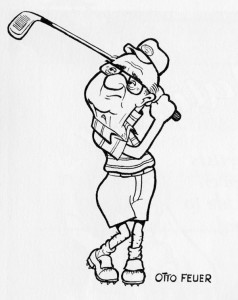 George Gordon (George Francis Gordon), considered one of the major Golden Age animators, began in 1930 at Terrytoons, where he became a director. He joined the exodus of Terry artists to the new MGM cartoon unit in 1937, where he animated in the Hanna and Barbera unit (Tom and Jerry) and sometimes directed (Barney Bear cartoons). He left in 1943 and worked for Hugh Harman (directing Trigger Joe cartoons) and John Sutherland on industrial films. During the last part of his career, Gordon directed TV shows for Terrytoons (The Deputy Dawg Show) and Hanna-Barbera (The Smurfs).
George Gordon (George Francis Gordon), considered one of the major Golden Age animators, began in 1930 at Terrytoons, where he became a director. He joined the exodus of Terry artists to the new MGM cartoon unit in 1937, where he animated in the Hanna and Barbera unit (Tom and Jerry) and sometimes directed (Barney Bear cartoons). He left in 1943 and worked for Hugh Harman (directing Trigger Joe cartoons) and John Sutherland on industrial films. During the last part of his career, Gordon directed TV shows for Terrytoons (The Deputy Dawg Show) and Hanna-Barbera (The Smurfs).
I. Klein (Isidore “Izzy” Klein) was an animator, story artist and independent animator, as well as an animation historian. His career dated back to 1918 at Hearst’s International Film Service and for Charley Bowers (Mutt and Jeff). He dropped out of animation in 1925 to become a “charter” cartoonist for The New Yorker and other magazines. He returned to animation in 1935 at Van Beuren’s before shifting to Mintz and Disney as storyman and animator. In 1940, he went to Terrytoons, where he helped create Mighty Mouse. After being fired by Terry for his union activities, Klein went to Famous where he eventually headed its Story Department. He ended his career as a freelance animator, served as president of Local 841 and edited its Top Cel newsletter. He also wrote for Cartoonists Profiles and made his own independent films. He was Phil Klein’s older brother.
Phil Klein (Philip Klein) got his first job in animation at Van Beuren’s in 1935 through his older brother, Izzy, eventually becoming an inbetweener. His activities on behalf of the Animated Motion Picture Workers Union led him to be fired and blackballed from New York studios. He did get work at Disney, where he became a Donald Duck specialist and helped organize the studio for the Screen Cartoonists Guild. After the strike, he briefly worked for Screen Gems, but during the war worked for the Army. Afterwards, he worked at various New York studios, including Shamus Culhane and Cineffects.
Fred Kopietz (Fred J. Kopietz) was hired by Ub Iwerks in 1930 to do layout and background work because of his experience in commercial art. He then moved to Lantz for most of the 1930s, where he also animated and directed. Kopietz then settled at Disney for much of the remainder of his career—from 1960-62 he did work at Bob Clampett’s Beany and Cecil and Hanna-Barbera on The Flintstones and commercials. At Disney he worked mostly on shorts, including a number of Donald Duck titles, and Sleeping Beauty.
 Walter Lantz (Walter Benjamin Lantz) got his start in animation at age 16 working at Hearst’s International Film Service. At Bray, he directed and starred in the Dinky Doodle films that mixed live action and animation, eventually taking over as head of production. He briefly worked in live action as a gag writer for Sennett comedies before being hired as a director on Universal’s Oswald cartoons. In 1935, Lantz became an independent producer making cartoons for Universal. The studio really hit its stride in 1939-40, with the introduction of Andy Panda and Woody Woodpecker. Lantz briefly released some cartoons through United Artists in 1947-48, but returned to Universal until 1972, when production of his theatrical cartoons ended. In 1984, he established the Walter Lantz Foundation.
Walter Lantz (Walter Benjamin Lantz) got his start in animation at age 16 working at Hearst’s International Film Service. At Bray, he directed and starred in the Dinky Doodle films that mixed live action and animation, eventually taking over as head of production. He briefly worked in live action as a gag writer for Sennett comedies before being hired as a director on Universal’s Oswald cartoons. In 1935, Lantz became an independent producer making cartoons for Universal. The studio really hit its stride in 1939-40, with the introduction of Andy Panda and Woody Woodpecker. Lantz briefly released some cartoons through United Artists in 1947-48, but returned to Universal until 1972, when production of his theatrical cartoons ended. In 1984, he established the Walter Lantz Foundation.
Norm McCabe (Norman McCabe) was born in England and joined Schlesinger in 1934, becoming an animator (Porky in Wackyland) and director (Daffy’s Southern Exposure). In 1943, he was drafted and assigned to the First Army Air Force Motion Picture Unit. After the war, after a stint at MGM, McCabe worked for several studios doing educational films, as well as commercial illustrations. He returned to theatrical animation in 1963 when he animated on Pink Panther cartoons, including the title sequence for The Pink Panther movie. McCabe continued working as until the 1990s at such studios as Filmation, Bakshi (Fritz the Cat), Warner Bros., Hanna-Barbera and Film Roman (Bobby’s World).
Marty Taras (Martin Bernard Taras/Morris Tarasinsky), animator and comic book artist, started out at Van Beuren in 1934 until it closed in 1936. At Fleischer, he became a leader of the 1937 strike, but abandoned the picket line to take a job at Jam Handy. Taras then worked at Terrytoons and Famous, where he created the character of Baby Huey and began a doing comic books. He later animated for Ralph Bakshi (Spider-Man, Fritz the Cat), Hanna-Barbera (Josie and the Pussycats) and The New York Institute of Technology (Tubby the Tuba).
Ruthie Tompson started out as a painter at Disney in 1935 on Snow White. She was subsequently moved to checking and scene planning, eventually becoming the Scene Planning Department Supervisor. In the process, Thompson became one of the first three women to be admitted to the Hollywood camera union. She worked on every Disney animated movie through The Rescuers. She also worked at Sanrio, Bakshi, Melendez and Spunbuggy.
Edith Vernick (Edyth Vernick/Ida Wernik) was born in Russia and began working for Max Fleischer in the early 1920s. She eventually became Manager of the Inbetween Department. In that role, Vernick seemed to have been blamed by management for helping cause the 1937 Fleischer strike; as a result, she was made an assistant animator, occasionally animated and wrote lyrics. She served in the WACS during the war, then worked in various capacities for Shamus Culhane, MGM and TV Spots.


 Harvey Deneroff is an independent film and animation historian based in Los Angeles specializing in labor history. The founder and past president of the Society for Animation Studies, he was also the first editor of Animation Magazine and AWN.com. Harvey also blogs at deneroff.com/blog.
Harvey Deneroff is an independent film and animation historian based in Los Angeles specializing in labor history. The founder and past president of the Society for Animation Studies, he was also the first editor of Animation Magazine and AWN.com. Harvey also blogs at deneroff.com/blog.




































































Leave a Reply